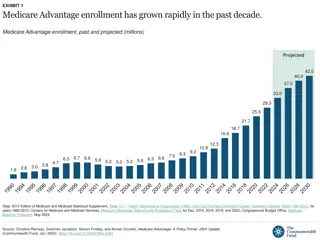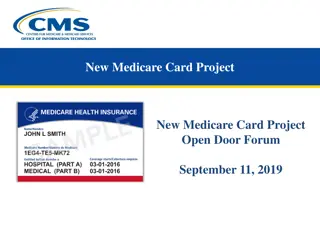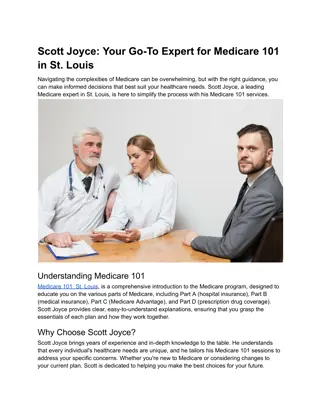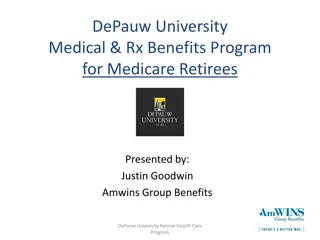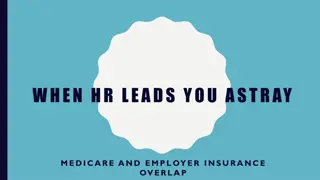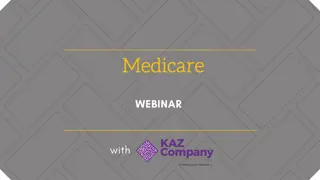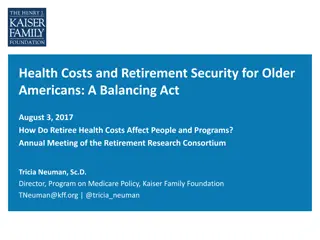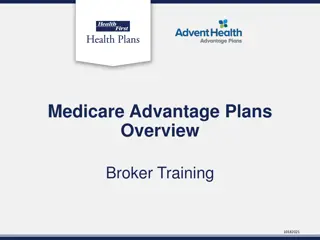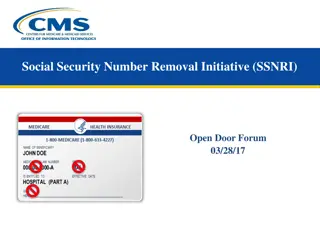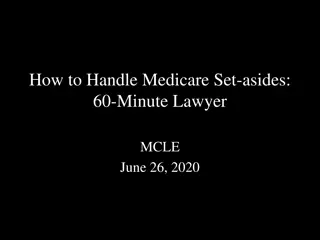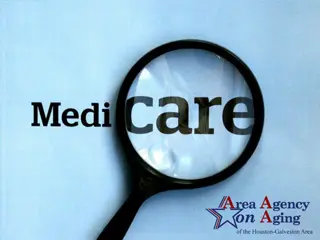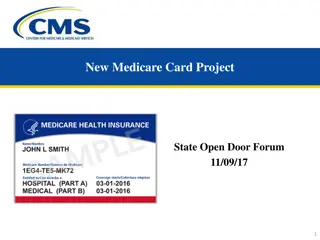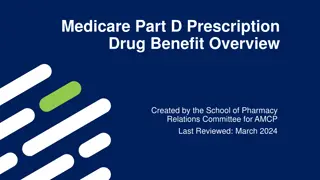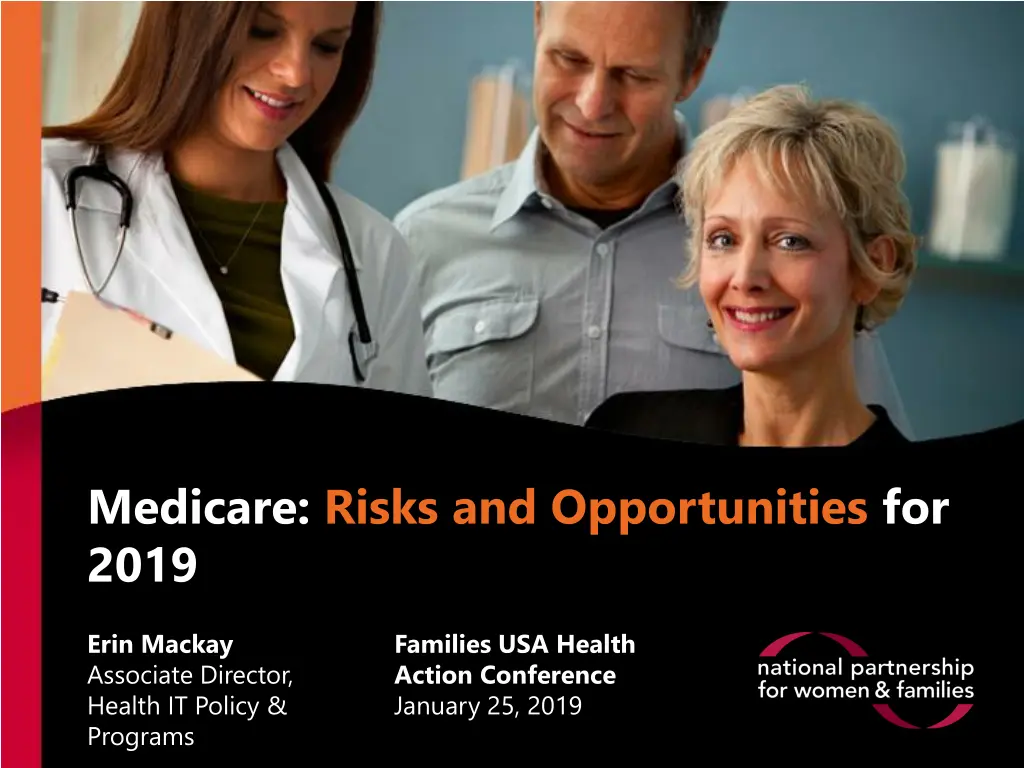
Understanding Medicare Risks and Opportunities in 2019
Explore the risks and opportunities associated with Medicare for 2019, including the shift towards value-based care, MIPS track updates, and the importance of quality healthcare delivery. Learn about the National Partnership for Women & Families' advocacy efforts and the push for fair workplace policies. Stay informed to make informed decisions regarding Medicare and healthcare policies.
Download Presentation

Please find below an Image/Link to download the presentation.
The content on the website is provided AS IS for your information and personal use only. It may not be sold, licensed, or shared on other websites without obtaining consent from the author. If you encounter any issues during the download, it is possible that the publisher has removed the file from their server.
You are allowed to download the files provided on this website for personal or commercial use, subject to the condition that they are used lawfully. All files are the property of their respective owners.
The content on the website is provided AS IS for your information and personal use only. It may not be sold, licensed, or shared on other websites without obtaining consent from the author.
E N D
Presentation Transcript
Medicare: Risks and Opportunities for 2019 Erin Mackay Associate Director, Health IT Policy & Programs Families USA Health Action Conference January 25, 2019
About us The National Partnership for Women & Families is a nonprofit, nonpartisan advocacy group dedicated to promoting fairness in the workplace, access to quality health care, and policies that help women and men meet the dual demands of work and family. More information is available at www.NationalPartnership.org. 2
Following the money Previous physician payment system, the Sustainable Growth Rate (SGR), implemented in 1997 Growing consensus of need to shift away from fee-for-service MACRA and the Quality Payment Program (passed in 2015) Eliminated annual uncertainty by repealing the SGR and stabilizing payment updates for physicians Created two payment tracks for providers: (1) Merit-Based Incentive Payment System (MIPS) (2) Alternative Payment Models (APMs) Why should consumers, advocates care? Progress toward paying for value, not volume 3
What is value-based care? A system that rewards and supports providers to: Deliver high-quality care Ensure ready access to care Effectively coordinate care Meaningfully engage patients and families Robust use of health information technology Address non-clinical needs Promote health equity Achieve better health outcomes Better as defined by patients/families; reflective of their goals, preferences, needs Patient-reported outcomes Patient experience Reduce health care disparities 4 Reduce cost
MIPS (Merit-based Incentive Payment Program) Track 1 (baby) stepping away from Fee-for-Service MIPS-eligible clinicians receive a composite score based on their performance in four categories: Quality Cost Meaningful use of certified EHR technology Clinical practice improvement activities Providers began reporting performance data in 2017, with the first payment adjustments going into effect January 01, 2019 2017 2019 2018 Quality (60%) Quality (50%) Quality (45%) Cost (10%) Cost (0%) Cost (15%) Technology* (25%) Technology* (25%) Technology (25%) Improvement Activities (15%) Improvement Activities (15%) Improvement Activities (15%) 5
Promising measures Quality performance category Average Change in Functional Status Following Total Knee Replacement Surgery Falls: Screening, Risk-Assessment, and Plan of Care to Prevent Future Falls Cost performance category Medicare Spending Per Beneficiary (MSPB) Total Per Capita Cost (TPCC) 8 episode-based cost measures (e.g., Knee Arthroplasty; Simple Pneumonia with Hospitalization) Technology* performance category Provide Patients Electronic Access to their Health Information Support Electronic Referral Loops by Receiving and Incorporating Health Information Electronic Prescribing bonus - Query of Prescription Drug Monitoring Program (PDMP) Clinical Practice Improvement Activities Provide Clinical Community Linkages Implement a Patient Navigator Program to Reduce Avoidable Hospital Readmissions PCP and Behavioral Health Bilateral Electronic Exchange of Information for Shared Patients 6
Outstanding questions How much of health care are we transforming? Pick your pace policies Number of participating clinicians (exclusions) Program complexity What s the goal of the Patients over Paperwork initiative? Reduce burden on providers Add additional flexibility What does this mean for consumers? Slower move toward a high-value system Little progress accessing meaningful quality information Further delay in technology functions that are a priority 7
Advanced APMs (Alternative Payment Models) Track 2 getting closer to value Providers qualify for the Advanced APM bonus if their payment model meets three criteria: Use quality measures comparable to MIPS Use certified EHR technology Bear at least nominal financial risk (or be a Medical Home Model expanded under CMS Innovation Center authority) Advanced APM Potential Benefits: 5 percent bonus APM-specific rewards Exclusion from MIPS 8
Examples Qualifying Advanced APMs for 2019 include: Accountable Care Organizations (ACOs) aremost commonly described as groups of physicians, hospitals and other health care providers that join together as one entity to take responsibility for improving the quality of care for their patients. Bundled payment is a single payment to providers or health care facilities (or jointly to both) for all services to treat a given condition or provide a given treatment. Oncology Care Model (OCM) is made up of physician practices under a specific payment arrangements that include financial and performance accountability for episodes of care surrounding chemotherapy administration for cancer patients. Comprehensive Primary Care Plus (CPC+) is a national advanced primary care medical home model that aims to strengthen primary care through regionally-based multi-payer payment reform and care delivery transformation. Comprehensive ESRD Care (CEC) models aim to identify ways to improve the coordination and quality of care for Medicare beneficiaries living with End Stage Renal Disease (ESRD). 9
Consumer priorities for new payment models APMs have the potential to provide the comprehensive, coordinated, patient- and family-centered care patients want and need while helping to drive down costs... If designed and implemented correctly! Improve delivery of safe, timely, high-quality care Meaningfully engage with patients and families Tie payment to quality of care Ensure health equity becomes an integral component of quality improvement Protect consumer rights 10
For more information Contact me: Follow us: Erin Mackay Associate Director, Health IT Policy & Programs emackay@nationalpartnership.org www.facebook.com/nationalpartnership www.twitter.com/npwf Find us: www.NationalPartnership.org www.GetMyHealthData.org 11


